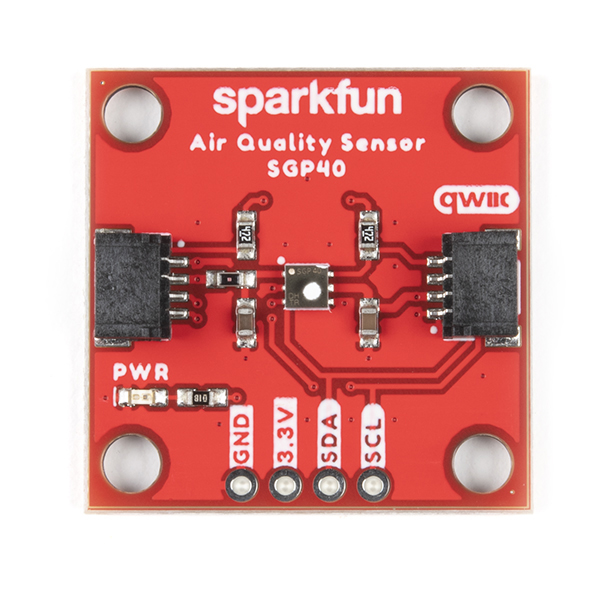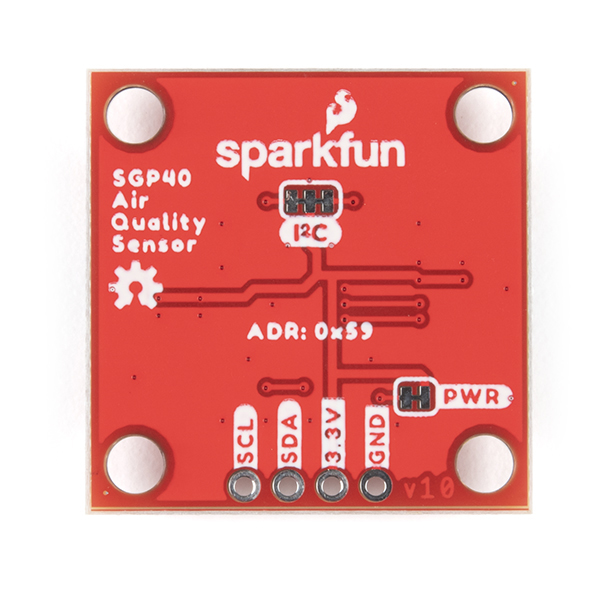SparkFun Air Quality Sensor - SGP40 (Qwiic)
The SparkFun SGP40 Air Quality Sensor provides a measurement of the quality of the air in your room or house. The SGP40 is based on Sensirion's CMOSens® technology and uses a metal oxide (MOx) sensor with a temperature controlled micro hotplate and provides a humidity-compensated volatile organic compound (VOC) based indoor air quality signal. Both the sensing element and VOC Algorithm feature an unmatched robustness against contaminating gases present in real world applications enabling a unique long term stability as well as low drift and device to device variation.
The SGP40 does not return specific concentrations or VOC gases. Instead, it outputs a digital value based on common VOC gases present in an indoor environment and this value can be combined with Sensirion's VOC Index Algorithm to detect the relative intensity of VOC events in relation to the average readings in a 24hr period. Think of the SGP40 as a sensitive electronic nose for detecting VOCs in a room.
The SGP40 communicates via I2C so naturally we broke out the pins on the sensor to Qwiic connectors so you can easily connect it to SparkFun's ever growing Qwiic Ecosystem!
The SparkFun Qwiic Connect System is an ecosystem of I2C sensors, actuators, shields and cables that make prototyping faster and less prone to error. All Qwiic-enabled boards use a common 1mm pitch, 4-pin JST connector. This reduces the amount of required PCB space, and polarized connections mean you can’t hook it up wrong.
- Uses I2C interface (Qwiic-enabled)
- I2C Address: 0x59
- 2x Qwiic connectors
- Operating voltage range:
- 1.7V - 3.6V (Typ. 3.3V)
- The Qwiic interface provides 3.3V
- Typical current consumption:
- 2.6mA during continuous operation (at 3.3V)
- 34µA when idle (heater off)
- Output signal:
- Digital raw value (SRAW): 0 - 65535 ticks
- Digital processed value (VOC Index): 0 - 500 VOC Index points
- Switch-on behavior:
- Time until reliably detecting VOC events: <60s
- Time until specifications are met: <1h
- Recommended sampling interval:
- VOC Index: 1s
- SRAW: 0.5s - 10s (Typ. 1s)
SparkFun Air Quality Sensor - SGP40 (Qwiic) Product Help and Resources
Air Quality Sensor - SGP40 (Qwiic) Hookup Guide
June 24, 2021
Get started measuring indoor air quality with the SparkFun Air Quality Sensor - SGP40 (Qwiic) Hookup Guide.
Monitor Sensor Data from Anywhere
August 10, 2022
Using WiFi to send sensor data from an ESP32 to a WiFi network and be able to read it from an IoT Dashboard from anywhere in the world.
Qwiic Kit for Raspberry Pi V2 Hookup Guide
December 29, 2022
Get started with the SGP40, BME280, VCNL4040, and microOLED via I2C using the Qwiic system and Python on a Raspberry Pi! Measure VOC Index, light, temperature, humidity, and pressure from the environment. Then display them on the microOLED, serial terminal, or the cloud with Cayenne!
Core Skill: Programming
If a board needs code or communicates somehow, you're going to need to know how to program or interface with it. The programming skill is all about communication and code.
Skill Level: Rookie - You will need a better fundamental understand of what code is, and how it works. You will be using beginner-level software and development tools like Arduino. You will be dealing directly with code, but numerous examples and libraries are available. Sensors or shields will communicate with serial or TTL.
See all skill levels
Core Skill: Electrical Prototyping
If it requires power, you need to know how much, what all the pins do, and how to hook it up. You may need to reference datasheets, schematics, and know the ins and outs of electronics.
Skill Level: Rookie - You may be required to know a bit more about the component, such as orientation, or how to hook it up, in addition to power requirements. You will need to understand polarized components.
See all skill levels
Comments
Looking for answers to technical questions?
We welcome your comments and suggestions below. However, if you are looking for solutions to technical questions please see our Technical Assistance page.
Customer Reviews
2 out of 5
Based on 1 ratings:
bad experience buying many (22) of these
been buying things from Sparkfun for a long time but never had a very bad experience until I bought many (22) of the same (sgp40) breeakout board. I previously bought two as part of the QWIIC kit v2 (2 kits - the ones from the kits worked) and decided to purchase 22 more after a couple months+ but the 22 did not work w/ the reference code even w/ tech support's help and worst part was I did not get to make those work, and had to RMA them back and wasted my two weeks and I did not get to show my class the sensors working and on top of that I was told that all those returned were functional but it was never explained how or what was done to make those work ...
My apologies for the unsatisfactory experience here. I was the tech that had worked on your case. Your boards not only passed my tests using our hook-up guide,(Qwiic cable + Redboard qwiic) but they also passed our QC tests in production and were restocked. My apologies for not providing this information sooner. I appreciate your feedback here and strive to do better next time.





I wonder if I can use this with an ESP32 in ESPHome and Home Assistant.